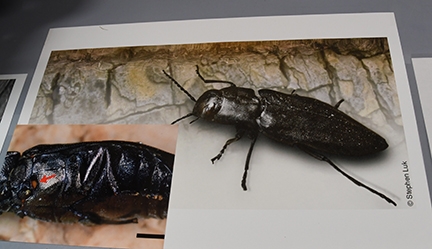
The fire beetles?
"Fire beetles in the genus Melanophila are sensitive to smoke and heat from smoldering trees after a fire," said Lynn Kimsey, director of the Bohart and professor of entomology at UC Davis. "They have a pair of pits on the body that detect heat. The beetles fly in large numbers to forest fires so they can lay their eggs in recently damaged trees.They will also crawl inside protective clothing of firefighters and bite them. Fire beetles will fly more than 50 miles to a fire."
Kimsey and animal biology major Crystal Homicz also told the crowd about smoke flies, which they described as "an odd group of platypezid flies use smoke plumes from burning trees to find mates. Swarms of 20 to 100 individuals can be seen 3 to 4 feet above the source of the smoke. They lay their eggs in burnt wood or soil near the burnt wood. Their larvae feed on burned plant parts and post-fire fungi."
Some insects can survive and thrive in extreme conditions beyond what humans could endure, they said. A sign read: "There are insects that can live in intense heat, cold, acidity or salinity, and some species are even attracted to fire. A wide variety of insects live in these extreme conditions, including flies, beetles, wasps and more."
Other signs informed the visitors of the insect peculiarities:
Heat
Many insects have a remarkable tolerance for high temperatures. No one knows how they survive and even thrive in these hot conditions. Several live at temperatures just below the boiling point of water.
- Desert Insects
Even more extreme are the desert insects that are active in sand dunes during the hottest part of the year. Sand surface temperatures can reach 180°F, but unlike hot springs, there is no water. These hot desert insects include sand wasps and ants. No one knows how they tolerate these temperatures and if you fell onto the sand, you would get second degree burns.
Sand Wasps
These wasps are active in our southern deserts in June and July. Air temperatures range between 100°F and 120°F with sand temperatures much higher. They collect dead insects to feed to their larvae, spending a great deal of time flying and resting on the superheated sand.
Ice
A number of very different kinds of insects spend all or part of their lives in temperatures below freezing. Some are so adapted they cannot survive temperatures about 50°F.
- Snow Fleas
Snow fleas belong to a family of scorpionflies called Boreidae. These are small, wingless predatory insects that feed on insects that they find on snow fields. The larvae feed in moss. They are found in the Sierra Nevada Mountains. - Snow Crickets
Grylloblattids, commonly known as snow crickets, are a group of extremophilic insects that live on mountaintops and on the edge of glaciers. They survive by eating insects that fall onto snow fields. Prolonged exposure to temperatures above 60°F. can be fatal, so just holding them in your hands could kill them.
Toxic Chemicals
A wide range of insects tolerate or even thrive on some quite toxic materials ranging from heavy metals to insecticides. These include orchid bees, lead cable borers and drugstore beetles.
- Male orchid bees in the species Eufriesea purpurata have been found to collect large amounts of DDT used to protect people living in rural homes in Brazil from malaria mosquitoes. The male bees use the DDT to make a pheromone to attract females. They were collected several other insecticides with no observable toxic effects.
- Lead Cable Borer can drill holes in the lead that sheaths telecommunications aerial telephone cables. This allows moisture to reach the copper wires and causes them to short, ruining the cable for 15 or 20 feet.
- Drugstore Beetles feed on a wide variety of dried plant products which are normally very toxic, including tobacco, spices, like cloves, habanero peppers and even strychnine. Their name derives from the period when drugstores compounded treatments for illnesses from plant material. These beetles are also major pests for the tobacco industry.
Hot Springs
Hot Spring Midges. One group of chironomid midges lives in hot springs with a temperature of 180°F. What's more remarkable is that in these hot conditions, there is little if any dissolved oxygen, yet the larvae do not breathe from the surface and obtain the oxygen they need from the water. One species is known from the hot spring pools of Yellowstone National Park.
Salt/Salinity
Halophiles are animals that live in highly salty environments. They must be able to tolerate the toxic effects of sodium and other chemicals in the water and maintain their internal water balance. Additionally, many of these salty inland waters have a pH close to that of ammonia.
- Brine Flies
Brine flies (family Ephydridae) thrive in extremely salty water. They live on the shoes of salt lakes, and lay their eggs in the water. One species lives in Mono Lake, which is three times as as salty as the ocean, and 11.6 times saltier than human blood! The adult flies live 3 to 5 days and they also can walk underwater and feed on algae. Local tribes ate the brine fly pupae.
Also during the open house, Bohart associates encouraged youngsters to participate in a family craft activity featuring colored yarn and cutout paper beetles. Red yarn indicated fire; blue yarn, the sky, and green yarn, vegetation. In addition, entomologist Jeff Smith, who curates the butterflies and moths, showed visitors part of the collection, and UC Davis students Karissa Merritt and Sara Guevara-Plunkett staffed the live "petting zoo," which includes Madagascar hissing cockroaches, walking sticks, and tarantulas.
Next Open House on Sept. 22
The next Bohart Museum open house, themed "Crafty Insects," is set from 1 to 4 p.m., Saturday, Sept. 22 at its location in Room 1124 of the Academic Surge Building on Crocker Lane. All open houses are free and family friendly.
"We will be having a two-way museum," said Tabatha Yang, education and outreach coordinator. "We will be displaying crafty--think cunning--insects and we are going to ask people to bring insect crafts that they have made, so all those folks who do felted, knitted, carved, sculpted crafters can share. Any and all hand-made, flea-shaped tea cozies are welcomed!"
The Bohart Museum houses a global collection of nearly eight million specimens. It is also the home of the seventh largest insect collection in North America, and the California Insect Survey, a storehouse of the insect biodiversity. In addition to the petting zoo, the museum features a year-around gift shop, which is stocked with T-shirts, sweatshirts, books, jewelry, posters, insect-collecting equipment and insect-themed candy.
The Bohart Museum's regular hours are from 9 a.m. to noon and 1 to 5 p.m. Mondays through Thursdays. It is closed to the public on Fridays, Saturdays and Sundays and on major holidays. Admission is free. More information on the Bohart Museum is available on the website or by contacting (530) 752-0493 or emailing bmuseum@ucdavis.edu
Attached Images:
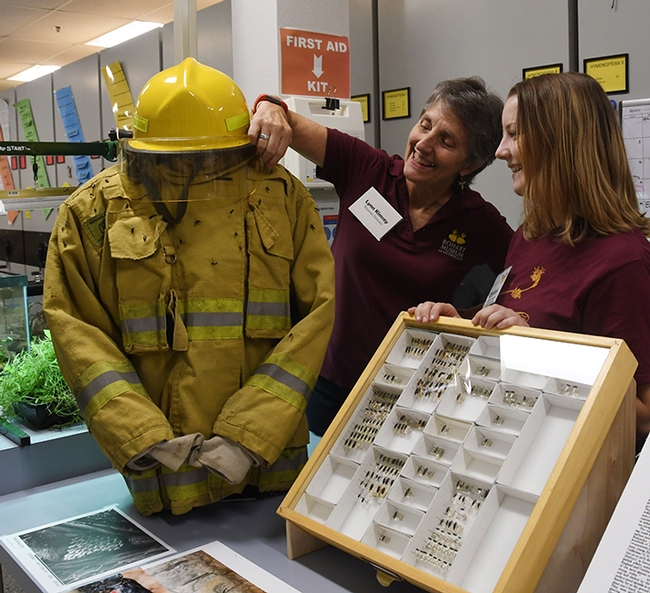
Lynn Kimsey, director of the Bohart Museum of Entomology and animal biology major Crystal Homicz look at the turncoat covered with pinned beetles. (Photo by Kathy Keatley Garvey)
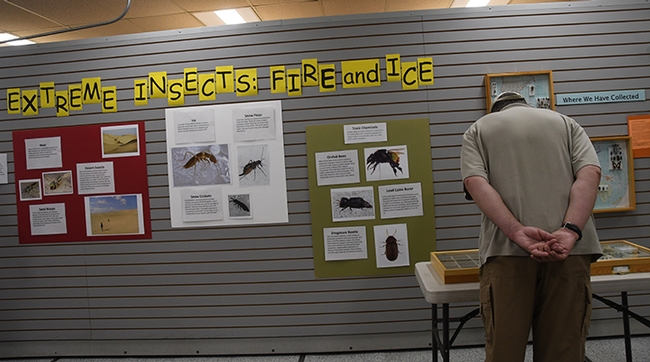
Visitors examined the Extreme Insects display at the Bohart Museum of Entomology open house. (Photo by Kathy Keatley Garvey)

Delsin Russell, 8, of Vacaville, wearing a T-shirt, "I Like Big Bugs; I Cannot Lie," asks a question of Lynn Kimsey, director of the Bohart Museum. At right is Delsin's mother, Beth Russell, who related that Delsin wants to become an entomologist. (Photo by Kathy Keatley Garvey)
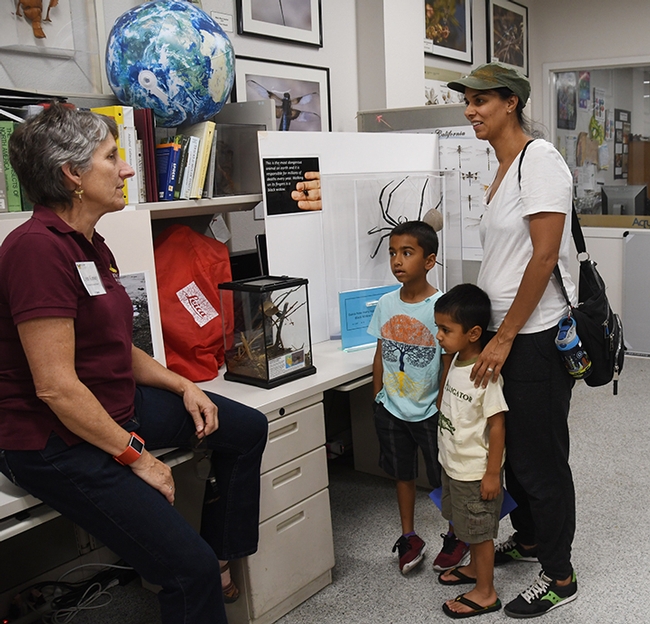
Folsom residents Ravi Kahlon and her sons Rohan Jagadeesan, 6, and Raja Jagadeesan,3, discuss extreme insects with Lynn Kimsey, director of the Bohart Museum. Ravi Kahlon is a 2001 graduate of UC Davis, majoring in philosophy.
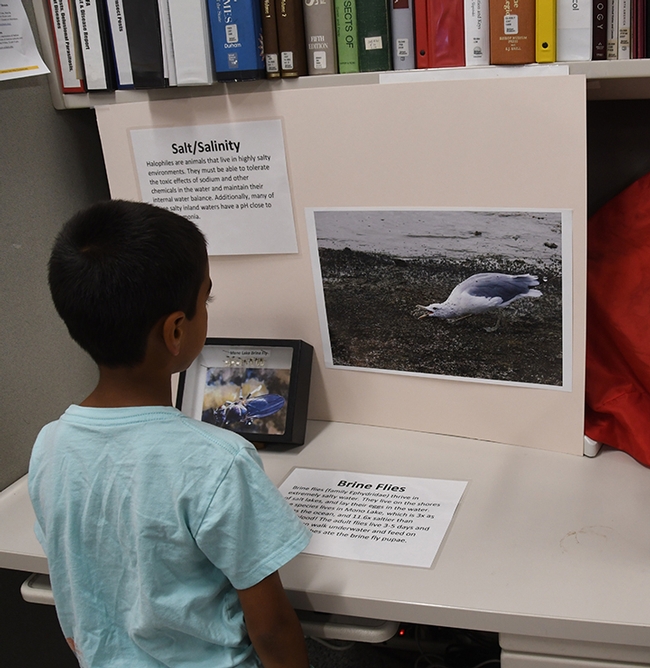
Rohan Jagadeesan, 6, of Folsom, reads all about insects who thrive in a salty habitat. (Photo by Kathy Keatley Garvey)
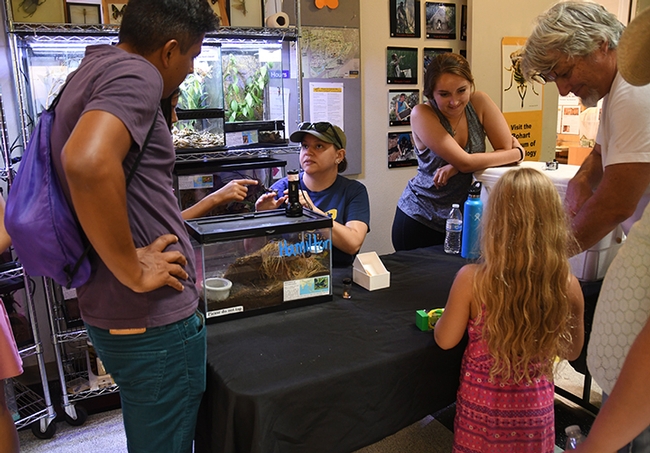
UC Davis students Karissa Merritt (center) and Sara Guevara-Plunkett staffed the live "petting zoo." (Photo by Kathy Keatley Garvey)

Participating in the family craft activity are (from left) Vacaville residents Rinka Matsumiya, 5, Kate Irwin, 3, and Kate's brother, Thomas Irwin, 8. (Photo by Kathy Keatley Garvey)
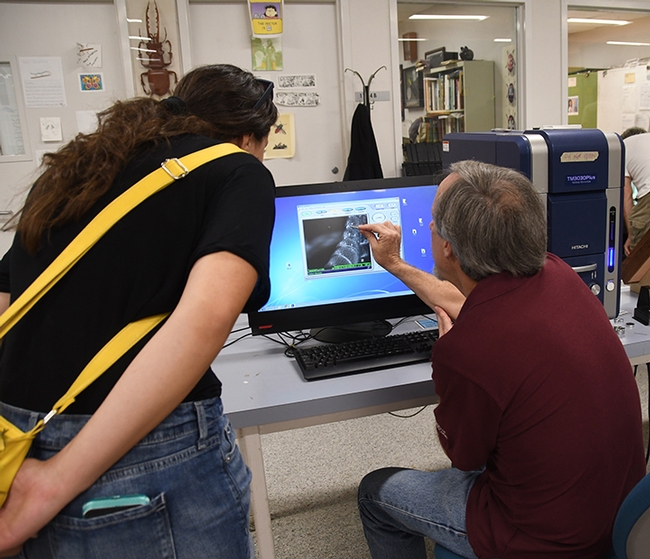
Senior museum scientist Steve Heydon chats with a visitor about parasites. (Photo by Kathy Keatley Garvey)